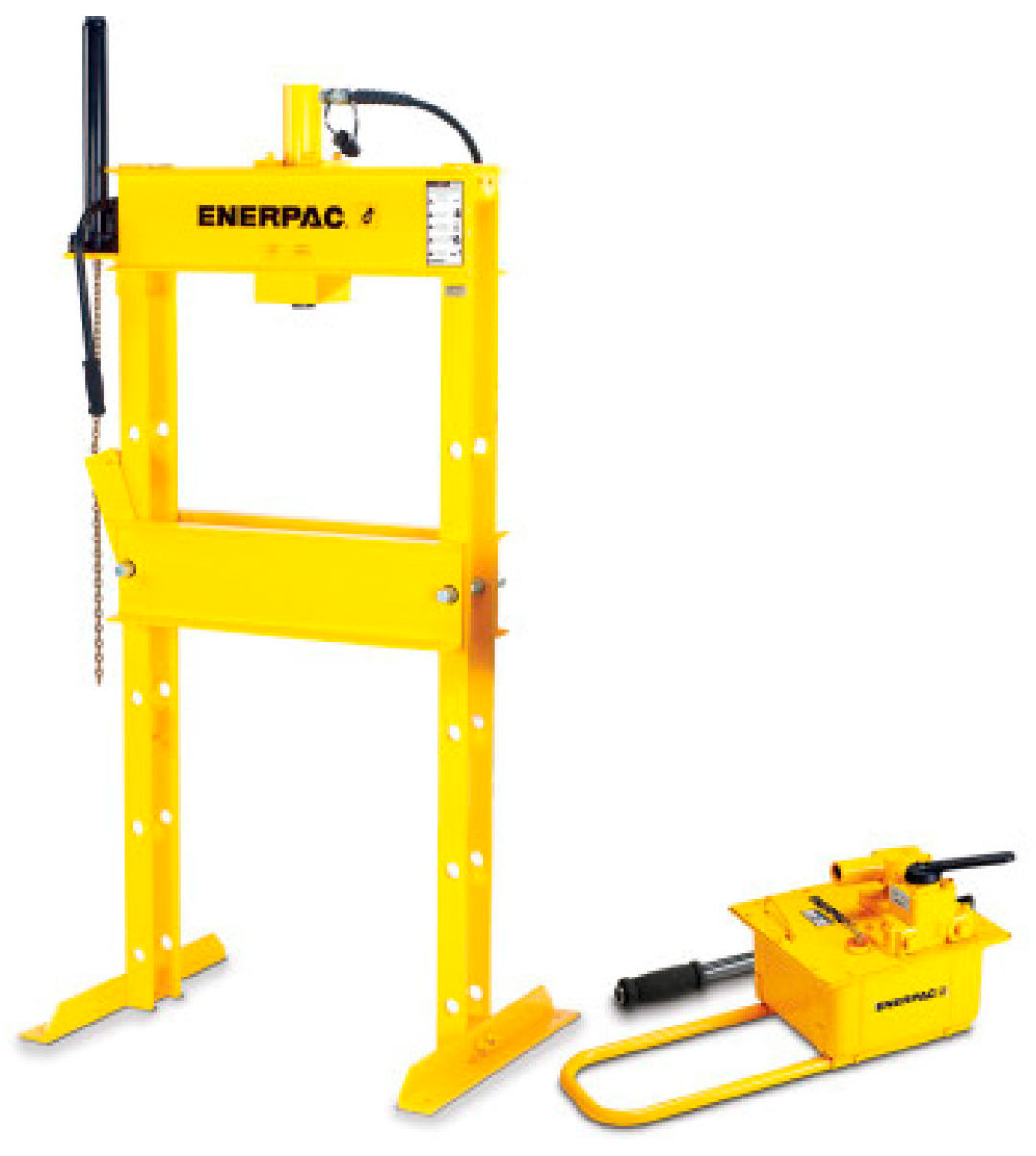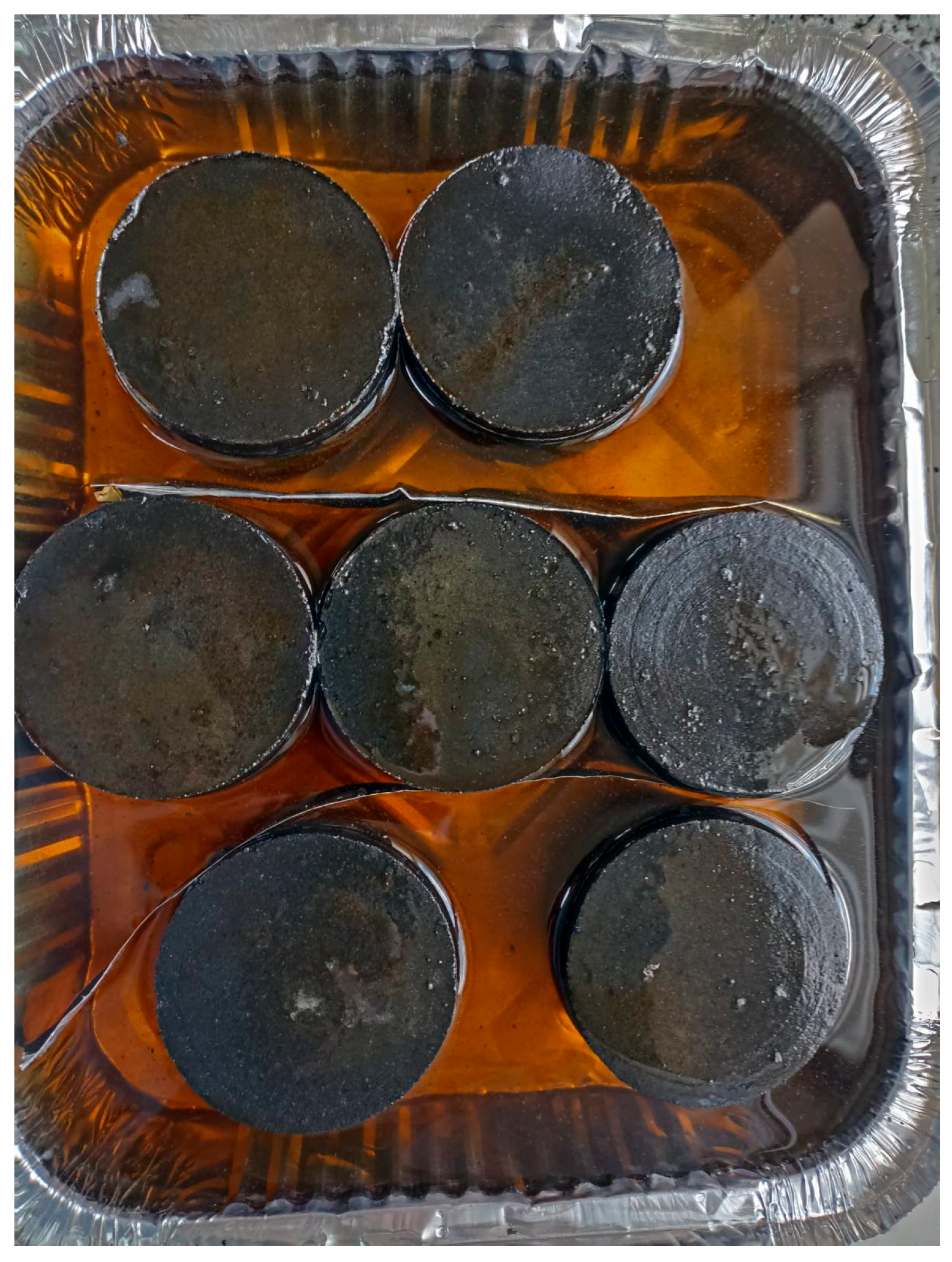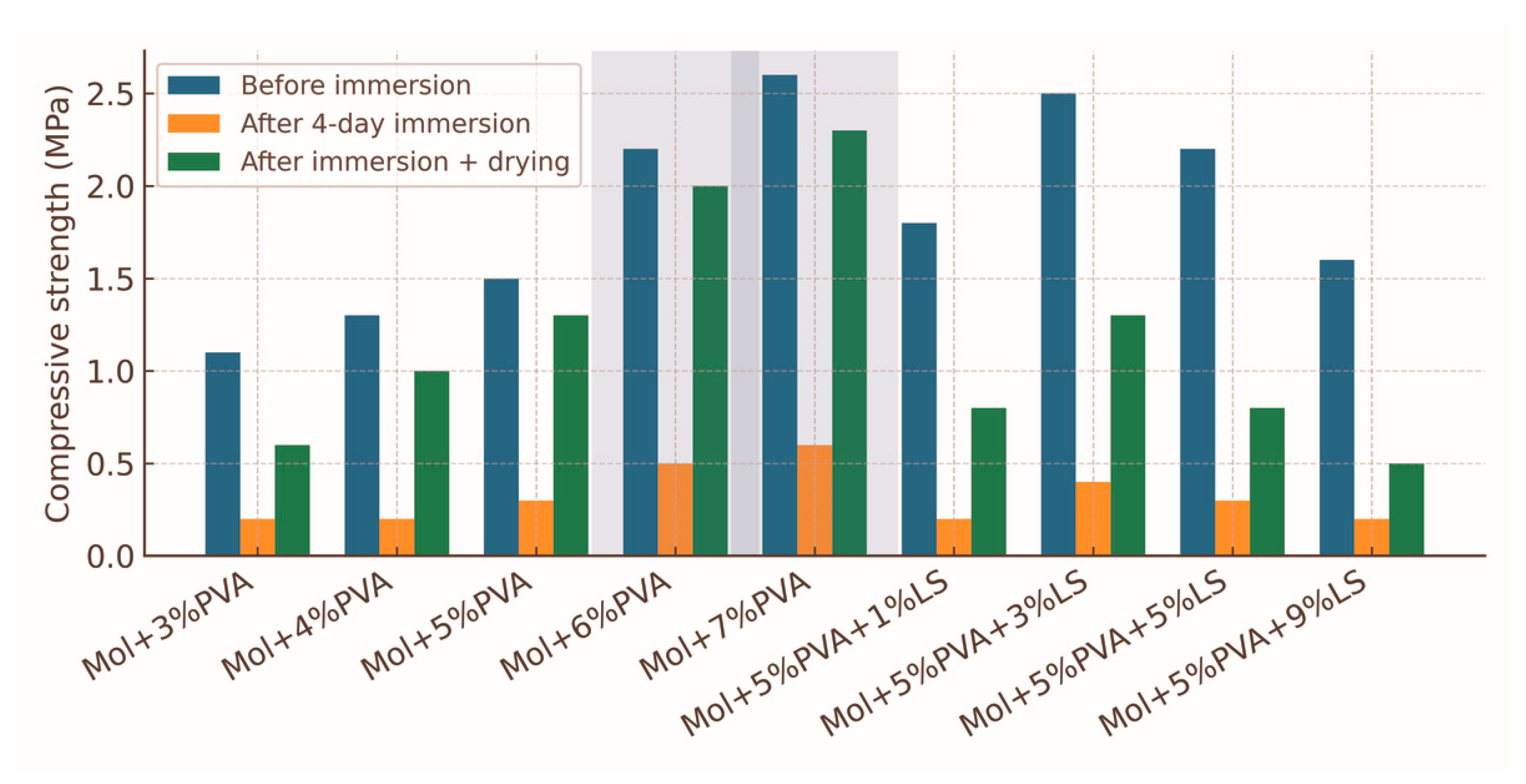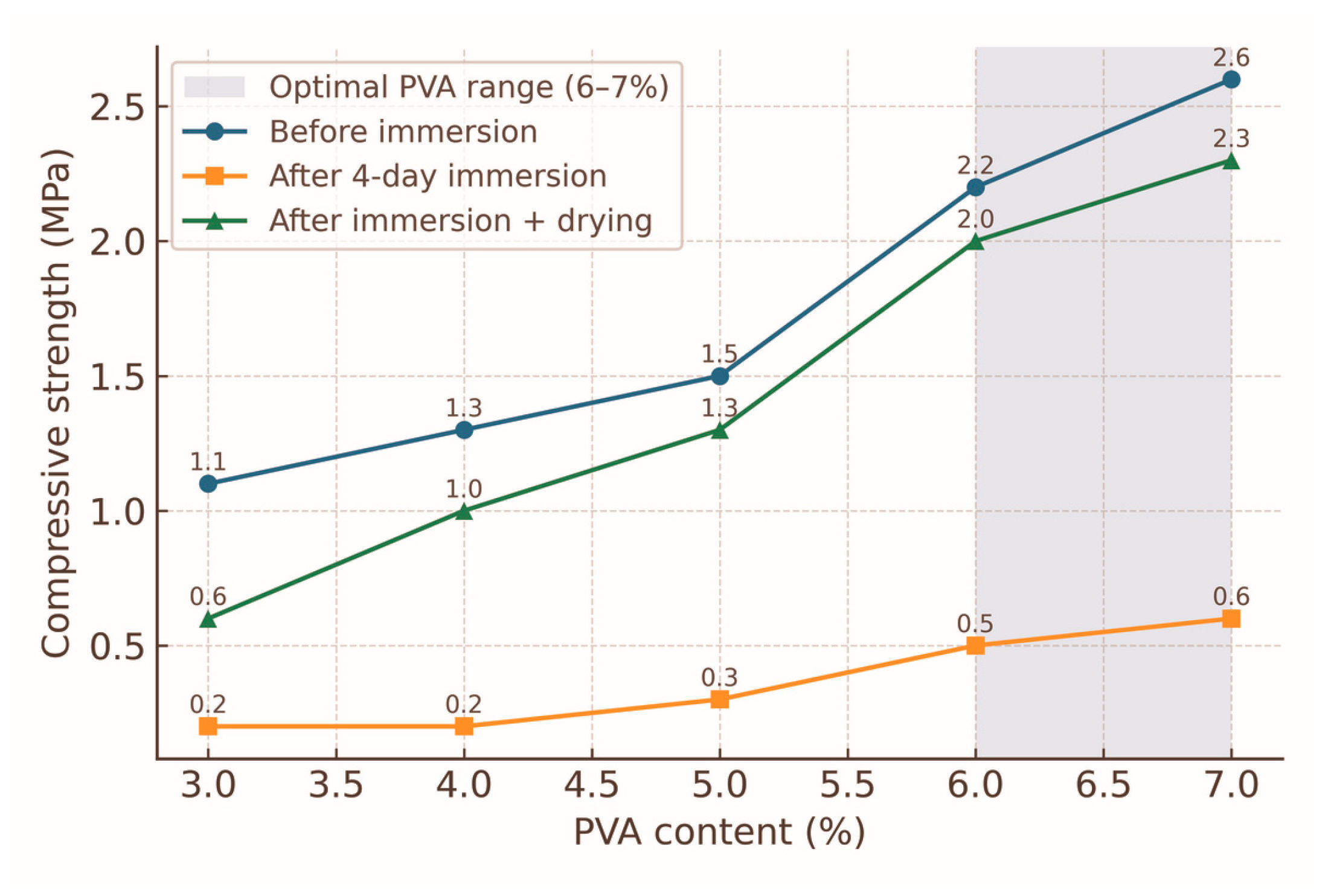Polyvinyl Alcohol-Based Binder Systems for Biomass and Charcoal Briquettes
Abstract
1. Introduction
2. Materials and Methods
2.1. Materials
2.2. Briquette Formation
2.3. Mechanical Strength Testing
2.4. Water Immersion and Absorption Measurement
2.5. Data Analysis
3. Results
3.1. Concentration Effects of PVA Binder
3.2. Strength vs. Binder Loading in Mixed Fractions
3.3. Binder Combinations and Additive Effects
3.4. Influence of Particle Size
3.5. Water Uptake Measurement
3.6. Fine Fraction (0–1 mm)—Effect of PVA Content on Absorption Kinetics
3.7. Coarse Fraction (0–3 mm)—Elevated Uptake and Faster Saturation
3.8. Binder Combinations—Liquid Soap as an Additive
3.9. Comparative Analysis Across All Formulations at Fixed Immersion Times
4. Discussion
5. Conclusions
Author Contributions
Funding
Data Availability Statement
Conflicts of Interest
Abbreviations
| PVA | Polyvinyl Alcohol |
| QUEEN | Quartz Enrichment Enabling Near-Zero Silicon |
References
- Obi, O.F.; Pecenka, R.; Clifford, M.J. A review of biomass briquette binders and quality parameters. Energies 2022, 15, 2426. [Google Scholar] [CrossRef]
- REN21. Renewables 2023 Global Status Report; REN21 Secretariat: Paris, France, 2023. [Google Scholar]
- Kaliyan, N.; Morey, R.V. Factors affecting strength and durability of densified biomass products. Biomass Bioenergy 2009, 33, 337–359. [Google Scholar] [CrossRef]
- Lubwama, M.; Yiga, V.A. Development of groundnut shells and bagasse briquettes as sustainable fuel sources for domestic cooking applications in Uganda. Renew. Energy 2017, 111, 532–542. [Google Scholar] [CrossRef]
- Liu, Z.; Jiang, Z.; Cai, Z.; Fei, B.; Yu, Y.; Liu, X. Effects of carbonization conditions on properties of bamboo pellets. Renew. Energy 2013, 51, 1–6. [Google Scholar] [CrossRef]
- Grover, P.D.; Mishra, S.K. Biomass Briquetting: Technology and Practices; FAO Regional Wood Energy Development Programme in Asia: Bangkok, Thailand, 1996. [Google Scholar]
- Marreiro, H.M.P.; Peruchi, R.S.; Lopes, R.M.B.P.; Andersen, S.L.F.; Eliziário, S.A.; Junior, P.R. Empirical studies on biomass briquette production: A literature review. Energies 2021, 14, 8320. [Google Scholar] [CrossRef]
- Benk, A.; Coban, A. Molasses and air blown coal tar pitch binders for the production of metallurgical quality formed coke from anthracite fines or coke breeze. Fuel Process. Technol. 2011, 92, 1078–1086. [Google Scholar] [CrossRef]
- Makgobelele, N.W.; Mbaya, R.K.K.; Bunt, J.R.; Leokaoke, N.T.; Neomagus, H.W.J.P. Evaluation of the mechanical properties of wood-derived charcoal briquettes for use as a reductant. J. S. Afr. Inst. Min. Metall. 2021, 121, 187–192. [Google Scholar] [CrossRef]
- Rajput, S.P.; Thorat, B.N. Recovered polyvinyl alcohol as an alternative binder for the production of metallurgical quality coke breeze briquettes. Int. J. Coal Prep. Util. 2019, 42, 475–485. [Google Scholar] [CrossRef]
- Patra, S.K.; Ghorai, S.; Sahu, N.; Kapure, G.U.; Tripathy, S.K. Synthesis of bio-polymer based composite binder for utilization of industrial coke dust waste. Fuel 2022, 311, 122502. [Google Scholar] [CrossRef]
- Nganko, J.M.; Koffi, E.P.M.; Gbaha, P.; Toure, A.O.; Kane, M.; Ndiaye, B.; Faye, M.; Nkounga, W.M.; Tekounegning, C.T.; Bile, E.E.J.; et al. Modeling and Optimization of Compaction Pressure, Binder Percentage and Retention Time in the Production Process of Carbonized Sawdust-Based Biofuel Briquettes Using Response Surface Methodology (RSM). Heliyon 2024, 10, e25376. [Google Scholar] [CrossRef] [PubMed]
- Shi, M.; Chen, T.; Wei, S.; Zhao, C.; Zhang, X.; Li, X.; Tang, X.; Liu, Y.; Yang, Z.; Chen, L. Molecular Docking, Molecular Dynamics Simulations, and Free Energy Calculation Insights into the Binding Mechanism between VS-4718 and Focal Adhesion Kinase. ACS Omega 2022, 7, 32442–32456. [Google Scholar] [CrossRef] [PubMed]
- Hasan, H.A.; Saharuddin, S.N.D.M.; Muhamad, M.H. Unlocking the Potential of Polyvinyl Alcohol (PVA) as a Biocarrier for Enhanced Wastewater Treatment: A Comprehensive Review. J. Water Process Eng. 2025, 74, 107780. [Google Scholar] [CrossRef]
- Wang, Y.; Zhang, T.; Huang, M.; Zhang, M.; He, Y.-C. Preparation of Dandelion Flower Extract-Based Polyvinyl Alcohol-Chitosan-Dandelion-CuNPs Composite Gel for Efficient Bacteriostatic and Dye Adsorption. Int. J. Biol. Macromol. 2024, 281, 136512. [Google Scholar] [CrossRef] [PubMed]
- Shen, K.; He, Y. Preparation and Application of Multifunctional Chitosan-Polyvinyl Alcohol-Nanosilver-Chrysanthemum Extract Composite Gel. Processes 2025, 13, 517. [Google Scholar] [CrossRef]
- Chin, O.C.; Siddiqui, K.M. Characteristics of Some Biomass Briquettes Prepared under Modest Die Pressures. Biomass Bioenergy 2000, 18, 223–228. [Google Scholar] [CrossRef]
- Mitchual, S.J.; Frimpong-Mensah, K.; Darkwa, N.A. Effect of Species, Particle Size and Compacting Pressure on Relaxed Density and Compressive Strength of Fuel Briquettes. Int. J. Energy Environ. Eng. 2013, 4, 30. [Google Scholar] [CrossRef]
- Okot, D.K.; Bilsborrow, P.E.; Phan, A.N. Effects of Operating Parameters on Maize Cob Briquette Quality. Biomass Bioenergy 2018, 112, 61–72. [Google Scholar] [CrossRef]
- Major, B.J.; Radu, G. Briquette Binder Composition. U.S. Patent 6,013,116, 11 January 2000. [Google Scholar]
- Yang, X.; Wang, W.; Long, M.; Xiang, L.; Cao, Y.; Hao, J. Relationship between Surfactant Content and the Properties of Microfibrillated Cellulose/High Density Polyethylene Composites. Polym. Compos. 2025, 46, 4947–4957. [Google Scholar] [CrossRef]
- Tumuluru, J.S.; Wright, C.T. A Review on Biomass Densification Technologies for Energy Application; Idaho National Laboratory (INL): Idaho Falls, ID, USA, 2010. [CrossRef]
- Olugbade, T.; Ojo, O.; Mohammed, T. Influence of Binders on Combustion Properties of Biomass Briquettes: A Recent Review. BioEnergy Res. 2019, 12, 241–259. [Google Scholar] [CrossRef]
- Kpalo, S.Y.; Zainuddin, M.F.; Manaf, L.A.; Roslan, A.M. A Review of Technical and Economic Aspects of Biomass Briquetting. Sustainability 2020, 12, 4609. [Google Scholar] [CrossRef]
- Gilvari, H.; de Jong, W.; Schott, D.L. Quality Parameters Relevant for Densification of Bio-Materials: Measuring Methods and Affecting Factors—A Review. Biomass Bioenergy 2019, 120, 117–134. [Google Scholar] [CrossRef]
- Awwal, O.A.; Israel, O.K.; Yashim, Z. Physico-Chemical, Calorific, and Emission Performance of Briquettes Produced from Maize Cob, Sugarcane Bagasse, and Polythene Composites. Avicenna J. Environ. Health Eng. 2019, 6, 49–54. [Google Scholar] [CrossRef]
- Omoniyi, T.E.; Igbo, P.K. Physico-Mechanical Characteristics of Rice Husk Briquettes Using Different Binders. Agric. Eng. Int. CIGR J. 2016, 18, 70–81. [Google Scholar]
- Davies, R.M.; Davies, I.E.E.; Davies, G.O. Studies on the Effect of Particle Size, Binder Ratio and Pressure on Compaction Energy of Water Hyacinth Briquettes. Asian Sci. Bull. 2024, 2, 148–155. [Google Scholar] [CrossRef]
- Filimon, A.; Dobos, A.M.; Onofrei, M.D.; Serbezeanu, D. Polyvinyl Alcohol-Based Membranes: A Review of Research Progress on Design and Predictive Modeling of Properties for Targeted Application. Polymers 2025, 17, 1016. [Google Scholar] [CrossRef]
- Davies, R.M.; Davies, O.A. Physical and Combustion Characteristics of Briquettes Made from Water Hyacinth and Phytoplankton Scum as Binder. J. Combust. 2013, 2013, 549894. [Google Scholar] [CrossRef]
- Song, B.; Cooke-Willis, M.; van Leeuwen, R.; Fahmy, M.; Hall, P. Insights into the Swelling Behaviours of Biomass and Biomass/Thermoplastic Briquettes under Water Penetration and Moisture Adsorption. Biomass Bioenergy 2023, 168, 106673. [Google Scholar] [CrossRef]
- Borowski, G.; Stępniewski, W.; Wójcik-Oliveira, K. Effect of Starch Binder on Charcoal Briquette Properties. Int. Agrophys. 2017, 31, 571–574. [Google Scholar] [CrossRef]
- Adeleke, A.A.; Odusote, J.K.; Ikubanni, P.P.; Adebisi, J.A.; Adesina, O.S.; Babatunde, D.E. Briquetting of Subbituminous Coal and Torrefied Biomass Using Bentonite as Inorganic Binder. Sci. Rep. 2022, 12, 8716. [Google Scholar] [CrossRef]
- Kodji, E.; Tize, K.J.; Awono, A.; Djoulde, D.R. Accessibility and Effects of Binder Types on the Physical and Energetic Properties of Ecological Coal. Heliyon 2022, 8, e11410. [Google Scholar] [CrossRef] [PubMed]
- Wu, S.; Zhang, S.; Wang, C.; Mu, C.; Huang, X. High-Strength Charcoal Briquette Preparation from Hydrothermal Pretreated Biomass Wastes. Fuel Process. Technol. 2018, 171, 293–300. [Google Scholar] [CrossRef]
- Song, L.; Li, Y.; Lei, T.; Yang, Y.; Shen, Y.; Yang, M.; Wang, Y.; Zheng, H. Research on the Water Absorption Diffusion Model and Kinetics of Pretreated Straw. Sci. Rep. 2025, 15, 9927. [Google Scholar] [CrossRef]
- Akbar, A.; Aslam, U.; Asghar, A.; Aslam, Z. Effect of Binding Materials on Physical and Fuel Characteristics of Bagasse-Based Pellets. Biomass Bioenergy 2021, 150, 106118. [Google Scholar] [CrossRef]
- Bajwa, D.S.; Peterson, T.; Sharma, N.; Shojaeiarani, J.; Bajwa, S.G. A Review of Densified Solid Biomass for Energy Production. Renew. Sustain. Energy Rev. 2018, 96, 296–305. [Google Scholar] [CrossRef]
- Craven, J.M.; Swithenbank, J.; Sharifi, V.N.; Peralta-Solorio, D.; Kelsall, G.; Sage, P. Hydrophobic Coatings for Moisture Stable Wood Pellets. Biomass Bioenergy 2015, 80, 278–285. [Google Scholar] [CrossRef]
- Ajith Kumar, J.; Vinoth Kumar, K.; Petchimuthu, M.; Iyahraja, S.; Vignesh Kumar, D. Comparative Analysis of Briquettes Obtained from Biomass and Charcoal. Mater. Today Proc. 2021, 45, 857–861. [Google Scholar] [CrossRef]
- Dai, X.; Theppitak, S.; Yoshikawa, K. Pelletization of Carbonized Wood Using Organic Binders with Biomass Gasification Residue as Additive. Energy Procedia 2019, 158, 509–515. [Google Scholar] [CrossRef]
- Butler, J.W.; Skrivan, W.; Lotfi, S. Identification of Optimal Binders for Torrefied Biomass Pellets. Energies 2023, 16, 3390. [Google Scholar] [CrossRef]
- Kabas, O.; Ercan, U.; Dinca, M.N. Prediction of Briquette Deformation Energy via Ensemble Learning Algorithms Using Physico-Mechanical Parameters. Appl. Sci. 2024, 14, 652. [Google Scholar] [CrossRef]
- Ji, X.; Guo, J.; Guan, F.; Liu, Y.; Yang, Q.; Zhang, X.; Xu, Y. Preparation of Electrospun Polyvinyl Alcohol/Nanocellulose Composite Film and Evaluation of Its Biomedical Performance. Gels 2021, 7, 223. [Google Scholar] [CrossRef]
- Ichsan, A.C.; Ningsih, R.V.; Rini, D.S.; Webliana, K. Combustion Performance and Physicochemical Characteristics of Sawdust-Based Bio-Charcoal Briquettes Using Molasses Adhesive. J. Sylva Lestari 2025, 13, 578–600. [Google Scholar] [CrossRef]
- Tambuwal, A.A.; Salihu, A.; Boyi, Y.M.; Garba, S.; Muhammad, A.S.; Sahabi, Y.; Umar, H.; Muhammad, M. Comparative Analysis of Gum Arabic and Molasses (Binders) in Briquette Produced from Millet Husk. J. Phys. Sci. Innov. 2022, 14, 13–27. [Google Scholar] [CrossRef]
- Alsaqoor, S.; Borowski, G.; Alahmer, A.; Beithou, N. Using of Adhesives and Binders for Agglomeration of Particle Waste Resources. Adv. Sci. Technol. Res. J. 2022, 16, 124–135. [Google Scholar] [CrossRef]
- Pacorel, B.; Hampson, C.A. Molasses Binder. European Patent EP2462169A2, 13 June 2012. [Google Scholar]
- Inkscape Project. Inkscape 1.3: Free and Open Source Vector Graphics Editor. 2023. Available online: https://inkscape.org (accessed on 18 September 2025).
- Clarke, D.E.; Marsh, H. Influence of coal/binder interactions on mechanical strength of briquettes. Fuel 1989, 68, 1023–1030. [Google Scholar] [CrossRef]
- Granado, M.P.P.; Suhogusoff, Y.V.M.; Santos, L.R.O.; Yamaji, F.M.; De Conti, A.C. Effects of pressure densification on strength and properties of cassava waste briquettes. Renew. Energy 2021, 167, 306–312. [Google Scholar] [CrossRef]
- Zepeda-Cepeda, C.O.; Goche-Tilles, J.R.; Palacios-Mendoza, C.; Moreno-Anguiano, O.; Niez-Retana, V.D.; Heya, M.N.; Carrillo-Parra, A. Effect of Sawdust Particle Size on Physical, Mechanical, and Energetic Properties of Pinus durangensis Briquettes. Appl. Sci. 2021, 11, 3805. [Google Scholar] [CrossRef]
- Kudo, S.; Otsuka, E.; Suzuki, A. Swelling behavior of chemically crosslinked PVA gels in mixed solvents. J. Polym. Sci. Part B Polym. Phys. 2010, 48, 1978–1986. [Google Scholar] [CrossRef]
- Ahn, B.J.; Chang, H.-S.; Lee, S.M.; Choi, D.H.; Cho, S.T.; Han, G.-S.; Yang, I. Effect of binders on the durability of wood pellets fabricated from Larix kaemferi C. and Liriodendron tulipifera L. sawdust. Renew. Energy 2014, 62, 18–23. [Google Scholar] [CrossRef]
- Somerville, M.A. The strength and density of green and reduced briquettes made with iron ore and charcoal. J. Sustain. Metall. 2016, 2, 228–238. [Google Scholar] [CrossRef]
- Kocer, A.; Kabas, O.; Zabava, B.S. Estimation of Compressive Resistance of Briquettes Obtained from Groundnut Shells with Different Machine Learning Algorithms. Appl. Sci. 2023, 13, 9826. [Google Scholar] [CrossRef]






| Fraction | Binder | Strength Before Water Immersion, MPa | Strength After 4 Days of Water Immersion, MPa | Strength After 4 Days of Water Immersion and Subsequent Drying, MPa |
|---|---|---|---|---|
| 0–1 mm | 20% molasses + 3% PVA | 1.1 | 0.2 | 0.6 |
| 0–1 mm | 20% molasses + 4% PVA | 1.3 | 0.2 | 1.0 |
| 0–1 mm | 20% molasses + 5% PVA | 1.5 | 0.3 | 1.3 |
| 0–1 mm | 20% molasses + 6% PVA | 2.2 | 0.5 | 2.0 |
| 0–1 mm | 20% molasses + 7% PVA | 2.6 | 0.6 | 2.3 |
| 0–3 mm | 20% molasses + 3% PVA | 0.9 | 0.2 | 0.5 |
| 0–3 mm | 20% molasses + 4% PVA | 1.1 | 0.2 | 0.7 |
| 0–3 mm | 20% molasses + 5% PVA | 1.3 | 0.3 | 1.0 |
| 0–3 mm | 20% molasses + 6% PVA | 1.6 | 0.4 | 1.2 |
| 0–3 mm | 20% molasses + 7% PVA | 1.7 | 0.5 | 1.4 |
| 0–1 mm | 20% molasses + 5% PVA + 1% liquid soap | 1.8 | 0.2 | 0.8 |
| 0–1 mm | 20% molasses + 5% PVA + 3% liquid soap | 2.5 | 0.4 | 1.3 |
| 0–1 mm | 20% molasses + 5% PVA + 5% liquid soap | 2.2 | 0.3 | 0.8 |
| 0–1 mm | 20% molasses + 5% PVA + 9% liquid soap | 1.6 | 0.2 | 0.5 |
| Fraction | Binder Composition | Dry Mass, g | Mass After 15 min, g | Mass After 30 min, g | Mass After 45 min, g | Mass After 60 min, g | Mass After 90 min, g | Mass After 120 min, g | Mass After 180 min, g | Mass After 300 min, g | Mass After 1 Day, g | Mass After 2 Days, g | Mass After 3 Days, g | Mass After 4 Days, g | Water Absorption After 15 min, % | Water Absorption After 30 min, % | Water Absorption After 45 min, % | Water Absorption After 60 min, % | Water Absorption After 120 min, % | Water Absorption After 180 Min, % | Water Absorption After 300 min, % | Water Absorption After 1 Day, % | Water Absorption After 2 Days, % | Water Absorption After 3 Days, % | Water Absorption After 4 Days, % |
|---|---|---|---|---|---|---|---|---|---|---|---|---|---|---|---|---|---|---|---|---|---|---|---|---|---|
| 0–1 mm | 20% molasses + 3% PVA | 254.7 | 268.0 | 276.6 | 285.2 | 295.9 | 314.0 | 334.0 | 378.2 | 383.1 | 393.6 | 383.3 | 384.9 | 385.0 | 5.22 | 8.60 | 11.97 | 16.18 | 31.13 | 50.41 | 50.41 | 54.53 | 50.49 | 51.12 | 51.16 |
| 0–1 mm | 20% molasses + 4% PVA | 261.9 | 271.3 | 276.9 | 283.2 | 291.5 | 307.6 | 326.4 | 373.3 | 380.3 | 384.9 | 382.0 | 383.8 | 385.1 | 3.59 | 5.73 | 8.13 | 11.30 | 24.63 | 45.21 | 45.21 | 46.96 | 45.86 | 46.54 | 47.04 |
| 0–1 mm | 20% molasses + 5% PVA | 253.0 | 263.3 | 266.2 | 268.0 | 270.2 | 273.8 | 278.7 | 308.7 | 337.1 | 395.3 | 390.1 | 391.3 | 388.4 | 4.07 | 5.22 | 5.93 | 6.80 | 10.16 | 33.24 | 33.24 | 56.25 | 54.19 | 54.66 | 53.52 |
| 0–1 mm | 20% molasses + 6% PVA | 274.9 | 286.3 | 289.1 | 329.1 | 293.3 | 297.4 | 302.7 | 327.2 | 348.4 | 421.0 | 417.7 | 420.1 | 422.3 | 4.15 | 5.17 | 19.72 | 6.69 | 10.11 | 26.74 | 26.74 | 53.15 | 51.95 | 52.82 | 53.62 |
| 0–1 mm | 20% molasses + 7% PVA | 288.9 | 299.1 | 301.2 | 302.9 | 304.8 | 307.4 | 311.4 | 330.7 | 345.2 | 441.4 | 432.6 | 437.2 | 436.8 | 3.53 | 4.26 | 4.85 | 5.50 | 7.79 | 19.49 | 19.49 | 52.79 | 49.74 | 51.33 | 51.19 |
| 0–3 mm | 20% molasses + 3% PVA | 250.2 | 313.8 | 331.9 | 341.2 | 346.4 | 354.3 | 358.8 | 369.4 | 373.8 | 392.2 | 388.9 | 389.2 | 388.6 | 25.42 | 32.65 | 36.37 | 38.45 | 43.41 | 49.40 | 49.40 | 56.75 | 55.44 | 55.56 | 55.32 |
| 0–3 mm | 20% molasses + 4% PVA | 241.6 | 295.3 | 314.5 | 327.6 | 335.5 | 344.7 | 349.8 | 362.0 | 365.6 | 380.5 | 377.0 | 379.1 | 381.1 | 22.23 | 30.17 | 35.60 | 38.87 | 44.78 | 51.32 | 51.32 | 57.49 | 56.04 | 56.91 | 57.74 |
| 0–3 mm | 20% molasses + 5% PVA | 244.8 | 281.2 | 291.0 | 300.6 | 307.9 | 322.8 | 332.1 | 352.5 | 360.9 | 380.3 | 380.0 | 381.1 | 382.2 | 14.87 | 18.87 | 22.79 | 25.78 | 35.66 | 47.43 | 47.43 | 55.35 | 55.23 | 55.68 | 56.13 |
| 0–3 mm | 20% molasses + 6% PVA | 241.0 | 333.0 | 341.0 | 346.8 | 350.8 | 356.9 | 359.6 | 371.3 | 373.0 | 391.9 | 387.6 | 390.5 | 388.7 | 38.17 | 41.49 | 43.90 | 45.56 | 49.21 | 54.77 | 54.77 | 62.61 | 60.83 | 62.03 | 61.29 |
| 0–3 mm | 20% molasses + 7% PVA | 270.2 | 340.6 | 350.3 | 357.4 | 361.7 | 368.5 | 373.0 | 383.8 | 386.7 | 409.3 | 400.6 | 405.5 | 404.4 | 26.05 | 29.64 | 32.27 | 33.86 | 38.05 | 43.12 | 43.12 | 51.48 | 48.26 | 50.07 | 49.67 |
| 0–1 mm | 20% molasses + 5% PVA + 1% liquid soap | 249.8 | 265.1 | 274.3 | 281.1 | 297.0 | 303.3 | 326.6 | 358.0 | 370.3 | 379.1 | 385.2 | 384.0 | 384.1 | 6.12 | 9.81 | 12.53 | 18.90 | 30.74 | 43.31 | 48.24 | 51.76 | 54.20 | 53.72 | 53.76 |
| 0–1 mm | 20% molasses + 5% PVA + 3% liquid soap | 249.6 | 261.9 | 270.6 | 276.2 | 291.3 | 300.9 | 324.1 | 360.8 | 372.5 | 376.0 | 380.1 | 379.5 | 380.0 | 4.93 | 8.41 | 10.66 | 16.71 | 29.85 | 44.55 | 49.24 | 50.64 | 52.28 | 52.04 | 52.24 |
| 0–1 mm | 20% molasses + 5% PVA + 5% liquid soap | 264.9 | 276.9 | 278.4 | 303.1 | 299.3 | 297.4 | 300.4 | 327.4 | 333.9 | 401.1 | 403.5 | 402.0 | 408.3 | 4.53 | 5.10 | 14.42 | 12.99 | 13.40 | 23.59 | 26.05 | 51.42 | 52.32 | 51.76 | 54.13 |
| 0–1 mm | 20% molasses + 5% PVA + 9% liquid soap | 261.2 | 280.2 | 300.2 | 311.9 | 339.9 | 400.3 | 377.2 | 399.1 | 393.5 | 400.3 | 409.3 | 416.2 | 415.9 | 7.27 | 14.93 | 19.41 | 30.13 | 44.41 | 52.79 | 50.65 | 53.25 | 56.70 | 59.34 | 59.23 |
Disclaimer/Publisher’s Note: The statements, opinions and data contained in all publications are solely those of the individual author(s) and contributor(s) and not of MDPI and/or the editor(s). MDPI and/or the editor(s) disclaim responsibility for any injury to people or property resulting from any ideas, methods, instructions or products referred to in the content. |
© 2025 by the authors. Licensee MDPI, Basel, Switzerland. This article is an open access article distributed under the terms and conditions of the Creative Commons Attribution (CC BY) license (https://creativecommons.org/licenses/by/4.0/).
Share and Cite
Korol, N.; Yankovych, V. Polyvinyl Alcohol-Based Binder Systems for Biomass and Charcoal Briquettes. Fuels 2025, 6, 81. https://doi.org/10.3390/fuels6040081
Korol N, Yankovych V. Polyvinyl Alcohol-Based Binder Systems for Biomass and Charcoal Briquettes. Fuels. 2025; 6(4):81. https://doi.org/10.3390/fuels6040081
Chicago/Turabian StyleKorol, Nataliya, and Viktor Yankovych. 2025. "Polyvinyl Alcohol-Based Binder Systems for Biomass and Charcoal Briquettes" Fuels 6, no. 4: 81. https://doi.org/10.3390/fuels6040081
APA StyleKorol, N., & Yankovych, V. (2025). Polyvinyl Alcohol-Based Binder Systems for Biomass and Charcoal Briquettes. Fuels, 6(4), 81. https://doi.org/10.3390/fuels6040081





